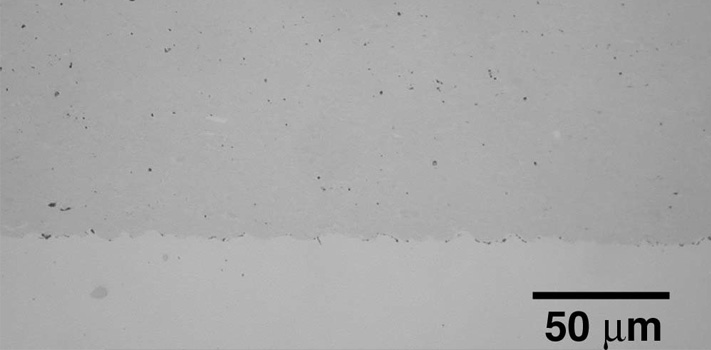Kinetic Metallization: Coatings Once Thought Impossible
KM-CrAlY
Low Temperature: < 800 deg F
Environmentally Safe: No Carcinogens
Thickness: 0.001"-0.050"
Fully Dense: 99%
KM benefits vs. HVOF
- Low Temperature
- Low Cost
- Highly directed
- Environmentally safe
- No soundproofing
- No grit blasting
- No explosive gas
KM MCrAlY Characteristics
- Near Zero Porosity
- High adhesion strength
- High oxidation resistance
- Low thermal flux
- No segregation
KM MCrAlY
MCrAlY coatings are widely utilized in high temperature applications. Operating temperatures are limited by the properties of materials at high temperatures. To avoid overheating structural components while increasing operating temperatures, heat flow in to the components is reduced by the use of thermal barrier coatings (TBCs). TBCs typically consist of a ceramic insulating layer bonded to an oxidation resistant MCrAlY coating. Failures of these thermal barriers are typically the result of loss of ceramic due to impact or spallation under thermal cycling and to oxidation.
Inovati’s Kinetic Metallization (KM) process has the advantage over other techniques for applying MCrAlY (M = Co, Ni, or Co/Ni) in that it achieves fully dense coatings and a strong metallurgical bond without the need for high-temperature heat-treatment in vacuum to allow inter-diffusion. The low temperature process used by Inovati also minimizes segregation and precipitation of the constituents, thus resulting in a more uniform and longer lasting protective surface. Being a highly directed (near line-of-sight) process, it minimizes, if not eliminates, the need for masking of the part resulting in significant savings in labor and increased throughput. Inovati’s patented KM process uses inert helium gas; no flammable or hazardous gas or fuel sources are required.
The MCrAlY coating applied with the KM approach offer higher quality than LPPS and HVOF in terms of minimal oxidation of the coating during the deposition process while avoiding their expensive equipment and elaborate processes. For this reason KM is now being used to coat critical surfaces like rocket nozzles.

